  Representatives from all eight local Site-Specific Advisory Boards (SSAB) and staff who attended the most recent EM SSAB National Chairs Meeting in April 2023 gather for a photo at the DOE headquarters James Forrestal Building. EM Principal Deputy Assistant Secretary Jeff Avery is also pictured at center.
Guidance throughout decades demonstrates boards' enduring influence
WASHINGTON, D.C. – Two advisory boards have provided 2,019 recommendations to EM since their inception, and the majority of them have been fully or partially implemented, demonstrating the boards’ critical role in shaping cleanup efforts, policies and practices.
Advice from the EM Site-Specific Advisory Board (EM SSAB) and Environmental Management Advisory Board (EMAB) has been reflective of community perspectives and strategic insights.
“When citizens actively engage in EM’s cleanup activities as volunteers through the advisory board programs and share diverse expertise and perspectives, it enables EM to effectively advance our mission through transparency and accountability,” says Joceline Nahigian, director for the EM Office of Intergovernmental and Stakeholder Programs. “We look forward to continued collaboration and input from our EM SSABs and EMAB partners to help inform decision making across the complex.”
 Members of the EM Site-Specific Advisory Board (EM SSAB), federal staff and contractors tour the Paducah Gaseous Diffusion Plant before the Spring 2022 EM SSAB Chairs Meeting in Paducah, Kentucky.
Nahigian highlighted an array of initiatives the boards have been a part of over the years.
“From teaming up to produce video documentaries on cleanup, to working with EM and its contractors to create educational and community programs, to providing recommendations on the Hanford Tank Waste Roadmap, the EM advisory board programs are home to some of the most active stakeholders surrounding the EM mission,” she said.
As of the fiscal year ending Sept. 30, EM SSAB has offered 1,782 recommendations, showcasing its active engagement and dedication to effective environmental management. Of those, 67% have been fully implemented, and 17% have seen partial implementation, indicating EM's commitment to community-led guidance.
Established in 1994, the EM SSAB represents a key component of community-based environmental management as the board is populated with community members who live and work near EM sites. This board was formed to provide site-specific advice and recommendations from the communities’ perspective, reflecting the unique challenges and conditions of EM sites located in Idaho, Kentucky, Nevada, New Mexico, Ohio, South Carolina, Tennessee and Washington state. Over the years, it has become a vital forum for local community involvement in cleanup decisions.
 Participants in a past Environmental Management Advisory Board meeting.
With its strategic focus, EMAB has provided 237 recommendations over its lifetime, including 31 in the previous fiscal year. This continuous involvement demonstrates the board’s integral role in guiding the EM program. The rate at which EM implemented EMAB’s advice is a testament to the board’s impact: 78% of these recommendations have been fully implemented, and 18% have been partially implemented.
Founded in 1992, EMAB has been pivotal in offering strategic and policy advice to the EM program. With subject matter experts and stakeholder representatives making up the board’s membership, its role has been crucial to shaping overarching strategies and ensuring EM's efforts align with broader environmental and public health perspectives.
Click here to learn more about the EM SSAB and here to learn about the EMAB.
-Contributor: Charles Love
  A view of two vessels that each contain approximately 30,000 pounds of granulated activated carbon. The material will be used to remove mercury from process off-gas during sodium-bearing waste treatment at the Integrated Waste Treatment Unit at the Idaho National Laboratory Site.
IDAHO FALLS, Idaho — EM crews have replaced carbon material from two vessels of the Integrated Waste Treatment Unit (IWTU) at the Idaho National Laboratory Site, allowing the plant to resume radioactive liquid waste treatment operations early next year.
Granular activated carbon (GAC), which has widespread uses in many industries, treats off-gas — a gas byproduct of a steam-reforming process — to remove mercury before the off-gas is sent to the IWTU’s exhaust stack. Once the off-gas is free of mercury, it is safe to discharge to the air.
Following five months of sodium-bearing liquid waste treatment, in which crews treated 68,000 gallons of waste from nearby underground waste tanks, the GAC beds within two vessels became loaded with mercury. Per operating procedures and permit requirements, once the GAC beds can no longer remove mercury from process off-gas, the plant must be shut down for bed replacement.
A specialty vacuum reached the vessels through 24-inch passageways. It was used to remove the spent carbon, which is being disposed of as Resource Conversation and Recovery Act waste.
Those same passageways were used to load new carbon. Crews also replaced three different-sized ceramic balls, which rest on the bottoms of the two vessels. The balls act as spacers to evenly distribute off-gas flow up through the GAC beds.
The IWTU uses steam-reforming technology to convert 900,000 gallons of radioactive liquid waste — generated between historic spent nuclear fuel reprocessing runs at the Idaho Nuclear Technology and Engineering Center — into a more stable granular solid. Following this conversion, the solids, about the size of coarse coffee grounds, are transferred to long, stainless steel canisters, which are then loaded into concrete vaults for onsite storage.
IWTU began radioactive liquid waste treatment in April and operated continually until September.
Project directors expect to resume operations early next year. Once the plant is at normal operating temperature and pressure, operators will introduce simulant and then transition to sodium-bearing waste once the facility is operating as expected.
-Contributor: Erik Simpson
 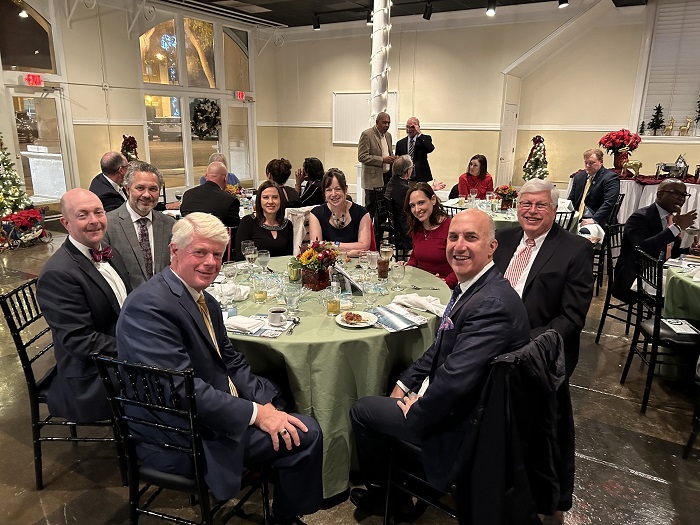 Participants in the Savannah River Site Community Reuse Organization (SRSCRO) annual meeting included, clockwise from center, Kristen Ellis, associate principal deputy assistant secretary for EM’s Office of Regulatory and Policy Affairs and EM director of regulatory, intergovernmental, and stakeholder engagement; Kara Colton, director of nuclear policy, Energy Communities Alliance (ECA); David Jameson, president and CEO, Aiken Chamber of Commerce; Seth Kirshenberg, executive director, ECA; Mike Budney, manager, Savannah River Operations Office; Will Williams, chair, SRSCRO Board of Directors; Robbie Bennett, president and CEO, SRSCRO; and Trenney Bennett.
AIKEN, S.C. — A community reuse organization created to address challenges and job loss stemming from the end of the Cold War hosted its annual meeting recently to celebrate 30 years of success serving five counties around Savannah River Site (SRS).
Among the speakers at the SRS Community Reuse Organization (SRSCRO) meeting were Kristen Ellis, associate principal deputy assistant secretary for EM’s Office of Regulatory and Policy Affairs and EM director of regulatory, intergovernmental, and stakeholder engagement, and Seth Kirshenberg, executive director of Energy Communities Alliance. Both gave remarks on their experiences with SRSCRO.
“I’ve worked with the SRSCRO for more than a decade. Their management of the Workforce Opportunities in Regional Careers (WORC) grant has generated a tremendous return on investment for our workforce and for the region’s economic future,” Ellis said.
The EM-funded Advancing Nuclear Skills Regionally Grant and WORC grants have provided 2,514 scholarships to more than 1,677 students, according to SRSCRO. Many of these students have gone on to work at SRS.
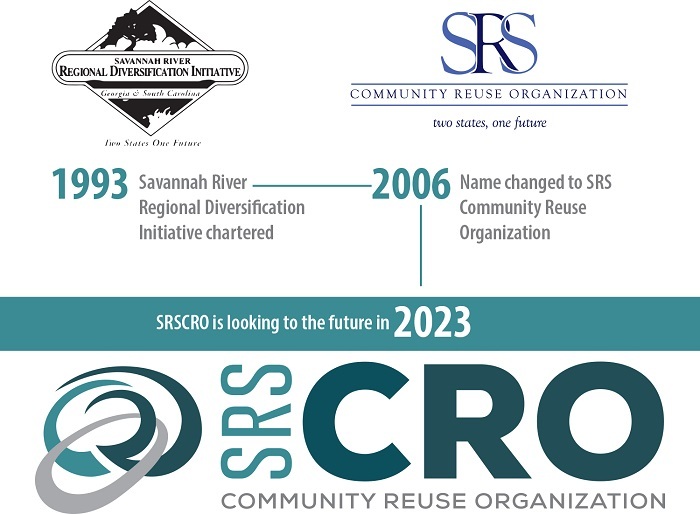 During the 30th anniversary event, the organization’s officials thanked outgoing board members and recognized Will Williams for his service as chair. The theme of the evening was “Cultivating Remarkable Outcomes.”
The successes of SRSCRO are made possible by the vision set by SRSCRO Board of Directors, key partnerships with community stakeholders, and a staff dedicated to ensuring success, according to the organization.
As SRS began a mission shift from production to cleanup resulting in the loss of nearly 12,000 jobs following the end of the Cold War, SRSCRO was established to identify ways to help create job opportunities for those impacted by the downsizing. Economic diversification was the primary mission. Over the course of the next 30 years, SRSCRO leveraged its roles to support regional economic development and workforce development through collaboration and partnership.
The nonprofit group’s present mission is to facilitate economic development opportunities associated with SRS technology, capabilities and missions and to serve as an informed, unified community voice for the two-state region, which includes the counties of Aiken, Allendale, and Barnwell in South Carolina and Columbia and Richmond in Georgia.
 Seth Kirshenberg, executive director of Energy Communities Alliance, provides remarks on his experience with the Savannah River Site Community Reuse Organization.
Through economic development support, SRSCRO has invested more than $16.7 million in startup businesses, economic development infrastructure, and community and workforce capacity building. This includes investing funds into five industrial parks across the two-state region.
Use of these funds by SRSCRO partners has enabled them to create 11,200 jobs and $5 billion in capital investment, and leverage more the $41 million in matching funds. And the group’s Asset Transition Program has saved SRS more than $12 million in cost avoidance.
In 2009, SRSCRO expanded its efforts to address the looming workforce challenge exacerbated by the retiring nuclear workforce. With a clear vision and new data, SRSCRO established the Nuclear Workforce Initiative. Through this program, the group established partnerships with EM and the National Nuclear Security Administration that would go on to provide more than $23.5 million in grant funding for new programs and student scholarships at local colleges and universities.
SRSCRO also focuses on the advancement of science, technology, engineering and math (STEM) education in the region. Through STEM Career Connections, it has reached more than 10,000 participants from 35 high schools in 11 counties. Since 2013, the efforts of SRSCRO and its regional partners have led to more than 96,000 participants with Nuclear Science Week programs and activities — an average of 30 events annually.
  UCOR Chief Engineer Christie Sudduth speaks with a student at Tennessee Tech University’s career fair. The partnership with Tennessee Tech is one of the newest in a university consortium with UCOR.
OAK RIDGE, Tenn. – Developing and maintaining a trained workforce is essential to continue advancing cleanup progress happening across DOE’s Oak Ridge Reservation.
With a significant percentage of the workforce eligible to retire in the next decade, Oak Ridge Office of Environmental Management (OREM) contractor UCOR is exploring new opportunities to build a pipeline of local qualified workers needed to maintain momentum at the site.
In one such effort, the contractor is looking to colleges and universities in the region to help shape the next generations of workers.
Building on past successes, the goals have become more ambitious with the establishment of a university consortium to formalize, sustain and expand partnerships with higher education institutions.
The consortium has provided a coordinated approach to partnerships with educational institutions, while growing opportunities. UCOR’s partnerships have grown to include the University of Tennessee, Roane State Community College, Pellissippi State Community College, Benedict College, Florida International University, Georgia Institute of Technology, Murray State University, Tennessee State University and, most recently, Tennessee Tech University.
“Developing and maintaining a trained workforce is essential to the future of companies like ours,” UCOR President and CEO Ken Rueter said. “Our industry needs the leaders that this program is producing. In Oak Ridge alone, there are jobs for decades to come associated with environmental cleanup.”
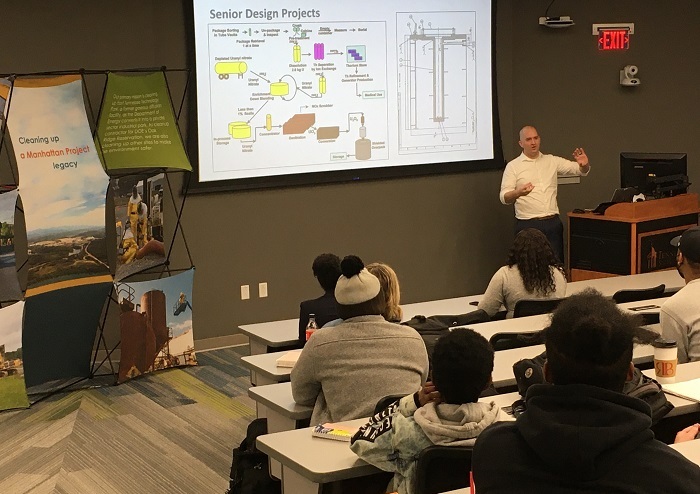 UCOR Nuclear Operations Manager Tommy Morgan speaks to students during a seminar at Tennessee State University. The contractor provides leadership and subject matter experts to participate in guest lecture series with the university.
The university consortium has proven beneficial to Oak Ridge’s cleanup mission as well as the students and schools involved. OREM and its contractors are attracting top talent, while students have a better awareness of impactful careers with advancement opportunities.
UCOR also supports the schools by offering the expertise of its executives and subject matter experts. These employees serve on the schools’ advisory boards and support curriculum development. In some partnerships, UCOR also provides scholarship endowments and support for first generation students.
The contractor also plans a calendar of activities for each school that includes student seminars, guest lecture series, student organizations and chapter meetings, demonstrations with state-of-the-art equipment unavailable in classrooms, and senior projects. These plans promote innovative learning and professional development.
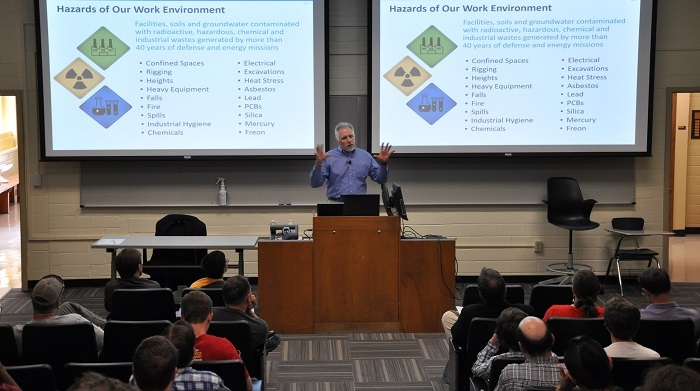 UCOR President and CEO Ken Rueter speaks to University of Tennessee students during an engineering colloquium series.
The university consortium is the latest initiative to cultivate the workforce of the future at Oak Ridge. In recent years, UCOR teamed up with higher education institutions to create educational opportunities that prepare students to work in the cleanup at Oak Ridge.
Through a partnership with the University of Tennessee’s nuclear engineering department and Oak Ridge Associated Universities, UCOR established the nation’s first minor degree in nuclear decommissioning and environmental management. The first students graduated with that focus in 2018.
UCOR then partnered with Roane State to support its efforts to create an associate degree in chemical engineering technology. The contractor also partnered with the American Federation of Labor and Congress of Industrial Organizations’ metal trades department to work with Roane State on offering a chemical operator program that provides students coursework and hands-on training through apprenticeships.
-Contributor: Shannon Potter
 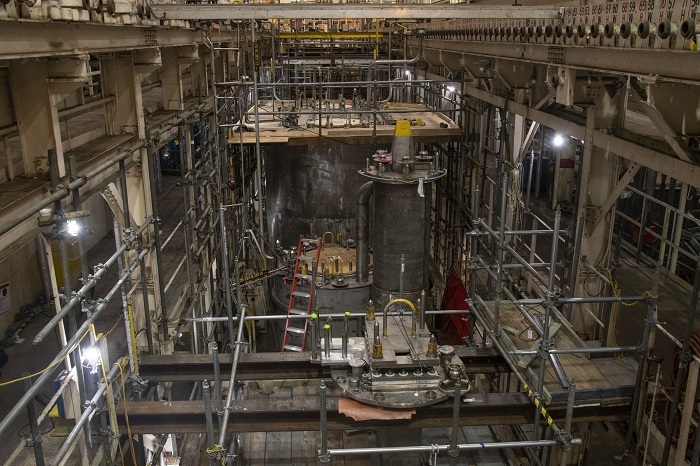 Crews installed an electrolytic dissolver in the H Canyon Chemical Separations Facility at Savannah River Site in January 2021 to dissolve nuclear material and support DOE’s nonproliferation mission. Before installing the dissolver there, employees conducted test runs in a mock-up facility.
Dissolving ‘dummy cans’ brings site a step closer to nonproliferation
AIKEN, S.C. – EM’s H Canyon Chemical Separations Facility at Savannah River Site (SRS) has arrived at a new milestone supporting disposal of nuclear material from a Japanese research reactor.
The achievement follows years of preparation by multiple site contractors that dissolved “dummy cans,” which are non-radioactive stainless steel containers similar to those that hold actual plutonium from Japan’s Fast Critical Assembly (FCA).
“This milestone is pushing H Canyon one step closer to dissolving nuclear material in support of the disposition of FCA fuel and the Department’s nonproliferation mission,” said Kevin Moeller, deputy facility manager for Savannah River Nuclear Solutions (SRNS), the site’s management and operations contractor. “The work we accomplish is making the world safer and we are excited to see advancements in this mission.”
Since 2019, H Canyon employees have conducted extensive planning for the FCA mission after the decision was made to send the FCA fuel to H Canyon to be dissolved and discarded as waste at SRS.
“The FCA fuel is different than the other material we have most recently been dissolving in H Canyon because it is coated in stainless steel cladding, rather than aluminum,” Moeller said. “The current dissolvers in the canyon are chemical dissolvers that use nitric acid to process the fuel; however, nitric acid alone doesn’t work on stainless steel. H Canyon had to replace a no-longer-in-service dissolver and install an electrolytic dissolver in its place.”
This is not the first time H Canyon has performed electrolytic dissolution. From 1969 to 1980, the facility used this method for fuel clad in stainless steel and zirconium. The fuel is lowered into a nitric acid solution, and electricity is used in the chemical dissolution process. This produces a liquid that is sent through the site’s liquid waste facilities, where it is made into glass through a process called vitrification. It is then safely stored onsite until a federal repository is identified.
“Our team is incredibly proud of this achievement that proves the electrolytic dissolver operates smoothly with only minor hiccups detected,” Technical Support Engineer and Dissolving Subject Matter Expert Nina Vinci said. “We plan to continue all startup related tasks and implement all new requirements to start dissolving the FCA fuel by February 2024.”
Moeller believes the extensive preparations ensured the success of the dummy can dissolution process and helped advance the FCA mission.
“This new milestone could not have been reached without the collaborative effort from organizations across SRS,” said Moeller. “With any new mission, you are bound to run into challenges along the way, but this team determined resolutions quickly and efficiently to remain on time and deliver top results.”
Japan’s Atomic Energy Agency sent the FCA fuel to SRS in 2016, fulfilling a pledge by Japan and the United States to remove all separated plutonium and highly enriched uranium from the FCA reactor in Japan. The fuel is currently stored onsite and will be transferred to the canyon for processing upon the completion of all preparation tasks. After the FCA campaign, the electrolytic dissolver can be used for dissolution for other non-aluminum based spent fuels, helping advance DOE’s nonproliferation mission.
-Contributor: Mackenzie McNabb
 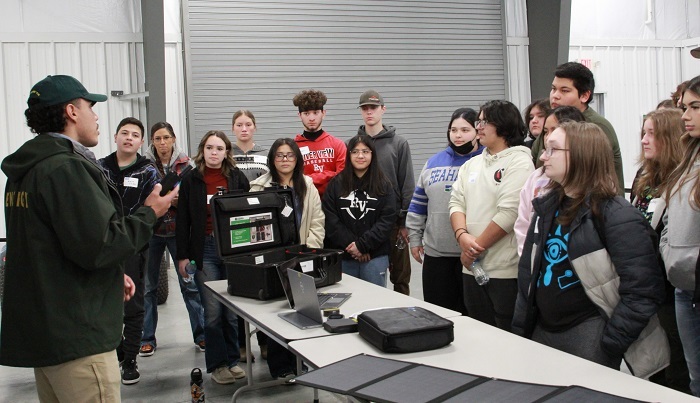 High school students recently took part in a “STEM Day” at Hanford to learn about the variety of careers available at the site.
RICHLAND, Wash. — Dozens of high school students recently came to the HAMMER Federal Training Center to experience a “STEM Day” and get an up-close look at the EM cleanup mission and Hanford Site career opportunities in science, technology, engineering and math fields.
“We’ve taken a lot of trips with students, and this was by far the best one we have done,” said April Bechen, coordinator for GEAR UP, a federal program helping students prepare for college. “To see how STEM is applied in different careers was so valuable.”
This is the second event of its kind this year hosted by EM Richland Operations Office contractor Hanford Mission Integration Solutions (HMIS) to support EM’s STEM Rising efforts and encourage workforce development in fields aligned with Hanford Site cleanup and DOE’s overall mission.
Hanford’s HAMMER was chosen as the venue for this STEM Day as the facility provides training for site employees on emergency response, health and safety. HAMMER stands for Hazardous Materials Management and Emergency Response.
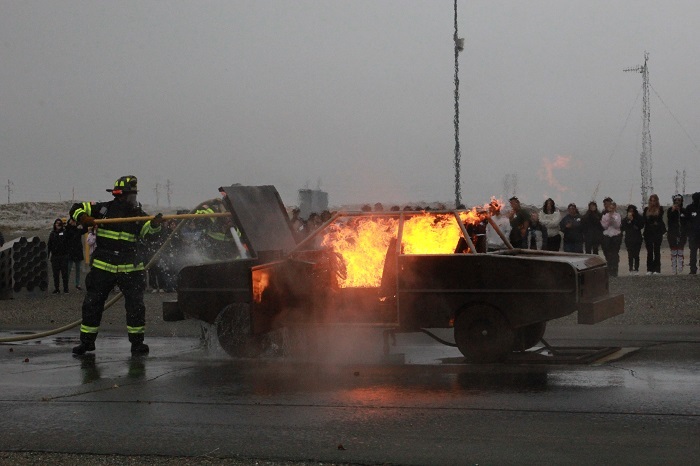 The Hanford Fire Department used a training prop to demonstrate emergency response to high school students as part of a recent “STEM Day” aimed at showing students the careers they can pursue at the Hanford Site.
 |
|
Students tried out radiation detection equipment as part of a recent career-connected learning opportunity on the Hanford Site. |
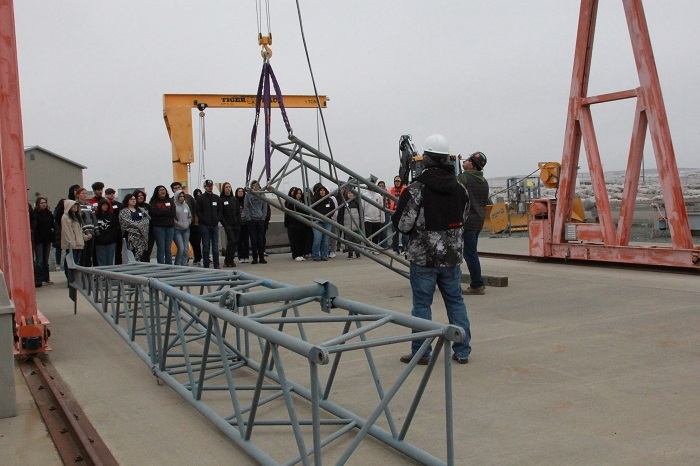 Hoisting and rigging instructors explained to students how the concepts they learn in algebra, geometry and trigonometry classes connect to raising a frame in the air, a typical job performed on the Hanford Site.
During their visit, students engaged in hands-on demonstrations across various disciplines, including respiratory protection, radiation safety, hoisting and rigging, emergency response and the K-9 program run by Hanford Patrol.
“I didn’t know there were so many careers available,” said Devin Nelson, a high school student. “I thought Hanford was just about nuclear, but it even has its own fire department.”
The students ended their visit at a career fair with human resources representatives from Hanford contractors and local higher education institutions to learn about the pathways to career and internship opportunities at Hanford. The career fair was organized through a partnership with The STEM Foundation, a Washington state nonprofit.
“I now know you can have any skill set and come here to work,” said Fern Cox, a high school student.
“Participation in these and similar events allows HMIS to showcase future job opportunities to the next generation of Hanford workers,” said Dan Seitz, Workforce Solutions manager for HMIS. “It also presents an ideal opportunity to introduce students to the One Hanford mission and our collaborative approach to cleanup.”
-Contributor: Robin Wojtanik
  Savannah River Mission Completion President and Project Manager Dave Olson talks with End Stream Delivery (ESD) control room operator Sherri Plunkett in the ESD control room, which has been reconfigured to support operations of two liquid waste facilities at EM’s Savannah River Site.
AIKEN, S.C. — An EM contractor at the Savannah River Site (SRS) continues to make progress integrating two key waste treatment facilities in pursuit of completing the liquid waste mission.
Liquid waste contractor Savannah River Mission Completion (SRMC) consolidated the control rooms used for operations of two different SRS liquid waste facilities — the Saltstone Production Facility (SPF) and Effluent Treatment Facility (ETF) — into one location.
SPF treats the decontaminated salt solution (DSS) that comes from the Salt Waste Processing Facility (SWPF) by mixing it with dry materials to form a grout, which is then poured into Saltstone Disposal Units to harden into a form safe for permanent onsite disposal. ETF treats low-level radioactive wastewater produced at SRS by removing contaminants to ensure compliance with the federal Safe Drinking Water Act before safely releasing it to the environment.
This consolidation of control rooms supports the organizational integration of SPF and ETF, which were combined last year into one program called End Stream Delivery (ESD). ESD reports to SWPF — the facility processing nearly 90% of the tank waste left in the SRS Tank Farms. The merger supports the best use of staffing resources and production optimization. A tank farm is a grouping of underground waste tanks.
SPF transitioned this year from four-day to 24-7 operations to support the increased DSS output from SWPF, which meant an increase in staffing needed for SPF. In turn, ETF is required to be staffed 24-7 for permitting purposes even though it doesn’t process continuously. Several factors, including weather and output from other site facilities, impact ETF’s operations schedule.
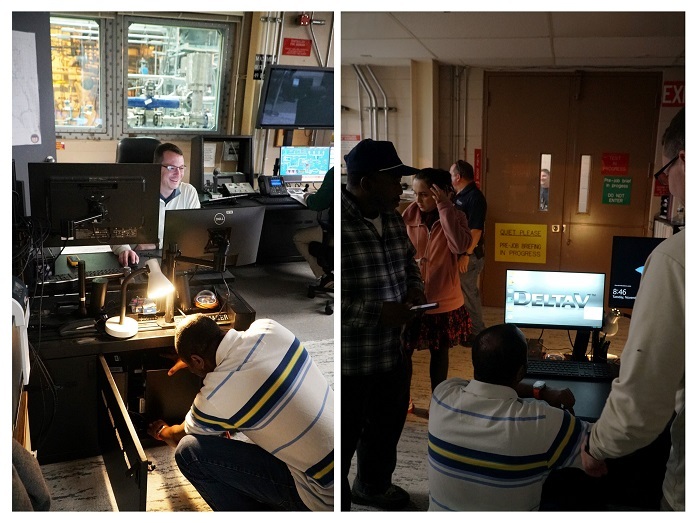 Distributed control system hardware upgrades were made to support operations in the newly consolidated control room for the Savannah River Site Liquid Waste End Stream Delivery.
Combining operations optimizes staffing resources that already exist within the liquid waste program, which saves money that can be used in other critical ways to advance the mission, according to Jim Folk, DOE-Savannah River assistant manager for waste disposition.
“Consolidating operations of two facilities under one organization is an example of continuous improvement and integration within the liquid waste program,” Folk said. “This effort benefits the acceleration of EM’s waste tank closure mission by ensuring all facets of the liquid waste system are ready for the high output of decontaminated salt solution from SWPF.”
From a management standpoint, merging the resources of SPF and ETF to create ESD made sense because they are both at the end of the pipe of the liquid waste system, which also lends to the name “end stream,” according to Dave Olson, SRMC president and program manager.
“Both the Saltstone Production and Effluent Treatment facilities provide critical functions for the entire liquid waste system. They are the final disposition of their respective processing streams,” Olson said. “Since End Stream Delivery’s primary role is in support of salt processing, it makes sense to align the two together as ESD under the SWPF project director. This effort, like many others we have undertaken, is focused on aligning our valuable resources to gain the most benefit.”
Under the new control room configuration, all operations for ESD will be controlled from SPF. The shift operations manager will be able to toggle between facility processing using one monitor. ETF will remain staffed with field operators and line management to conduct rounds, monitor processing, etc.
During the reconfiguration, SRMC construction crews made upgrades to the control room, such as new ergonomic workstations and consoles, control switches and printers. To support staffing of both facilities, operators from SPF and ETF are being cross-trained to become dual-qualified at both facilities.
-Contributor: Colleen Hart
 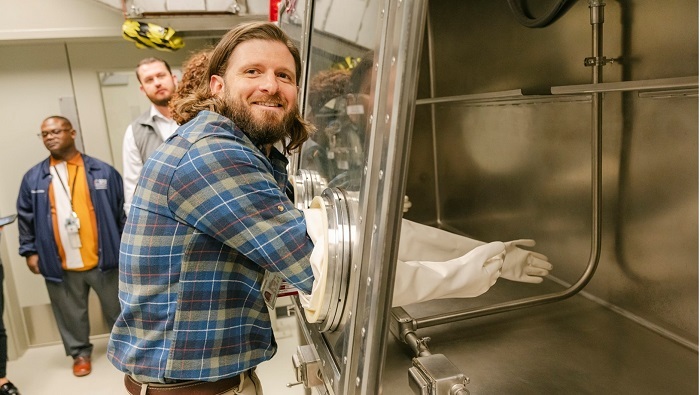 Cam McConnell, Augusta Tech architectural and engineering student, tests out a glovebox during a student tour as part of National Apprenticeship Week.
AIKEN, S.C. – Savannah River Site (SRS) contractors recently celebrated the U.S. Department of Labor’s 9th Annual National Apprenticeship Week with site-wide and community events to bring awareness to 22 different registered apprenticeship occupations.
“Since 2020, our Nuclear Operator Apprenticeship Program has grown from 10 students to over 100 per cohort and proves to be a valuable pipeline to secure high-paying careers across the site,” said Dorian Newton, deputy director of site training at SRS management and operations contractor Savannah River Nuclear Solutions (SRNS). “Through various events and tours, SRNS has successfully supported National Apprenticeship Week while showcasing our most valuable occupations.”
Established by the Labor Department in 2015, National Apprenticeship Week promotes high-quality, inclusive, in-demand career pathways through registered apprenticeships. SRS aimed to connect career seekers to the apprenticeships and careers available in science, technology, engineering and math fields.
“We kicked off the weeklong celebration by recognizing 45 active apprentices from Aiken Technical College and Denmark Technical College with an appreciation luncheon,” said BooBoo Roberts, SRNS Apprenticeship School and Pipeline Training manager. “With 91% of our apprentices transitioning into full-time positions at the site, the Apprenticeship School and Pipeline Training (APT) team continues to encourage apprentices to strive for excellence until the completion of the program.”
To bring more awareness and access to apprenticeship programs for students and educators, the APT team led other events that included online community webinars, program discussions and career fairs.
“The APT team connected with over 25 seniors, career specialists and guidance counselors at Silver Bluff High School and 50 students from Estill Middle School to promote our four career paths,” said Adam Smith, SRNS apprenticeship program lead. “It is so important to share a game plan for these occupations to middle and high school students to help prepare them for a fulfilling career at SRS.”
Fourteen students and instructors from Augusta Technical College visited SRS to learn more about apprenticeships and career opportunities in engineering, welding, chemical tech, industrial systems and mechatronics. Students also toured the SRS Waste Solidification Building and EM’s Savannah River National Laboratory.
Augusta Tech Architectural and Engineering student Cam McConnell says he jumped at the opportunity to tour the site and learn more about available full-time employment options.
“I’ve tried to get my foot in the door for a couple of years now,” said McConnell. “I knew working at the site was a tremendous opportunity, but the tour focused on the engineering opportunities, convenient work schedules and the ability to grow within the company, which was very exciting to me. I plan to use this degree and my prior military experience to land an engineering job at SRS in the future.”
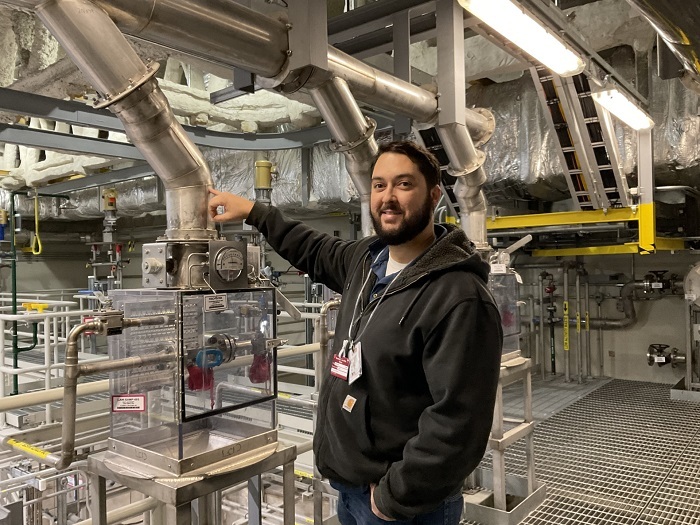 In celebration of Nuclear Apprenticeship Week, Daniel Ball, welding instructor, Aiken County Career and Technology Center, toured the Waste Solidification Building at Savannah River Site and learned about apprenticeship opportunities available to students.
The week concluded with an educator tour of H Canyon that included career-focused discussions with nearly 30 career specialists, guidance counselors, regional workforce advisors and adult educators from surrounding counties.
Aiken High School Counselor Jacquetta Hammonds and Langley-Bath-Clearwater Middle School Counselor Aretha Tarver participated in that tour to bring new opportunities to their students.
“A four-year degree is not always the perfect path for some students,” said Hammonds. “The apprenticeship program is a great option that connects students with a well-paying job and two-year degree that can support their families.”
Said Tarver, “Many of our eighth graders want to broaden their scope and learn about potential careers close to home. With this information, I can help shed some light on potential careers in the nuclear industry and connect them to on-the-job experiences and training at SRS.”
SRNS has 22 apprenticeship programs that are key to recruitment and are built around four career paths: nuclear facility/production operators, maintenance mechanics, quality assurance inspectors and electrical and instrumentation mechanics. Successful partnerships with the Lower Savannah Council of Governments, Apprenticeship Carolina, Aiken Technical College, Denmark Technical College, Augusta Tech and Orangeburg-Calhoun Technical College have allowed apprentices to gain paid on-the-job training and networking opportunities.
“We are so grateful to our partners who have helped transition over 300 apprentices into full-time occupations since 2020,” said Newton. “We will continue to highlight and celebrate these partnerships and the 22 apprenticeship programs that help maintain a sustainable workforce, minimize the duration of required training and ensure our contractors are supplied with qualified personnel to support SRS missions.”
-Contributor: Mackenzie McNabb
|




